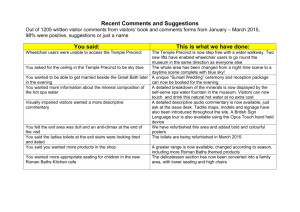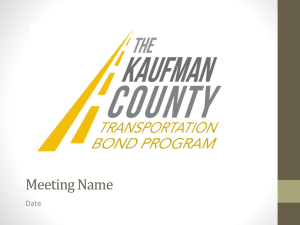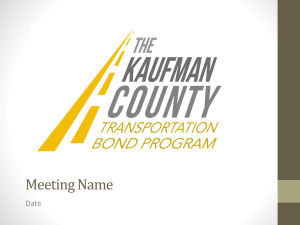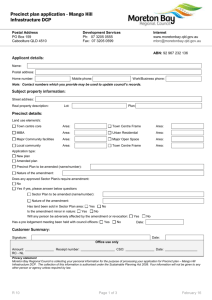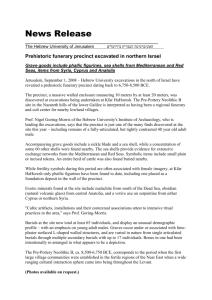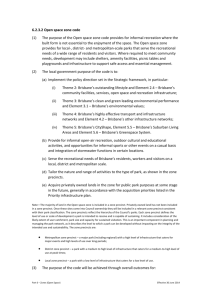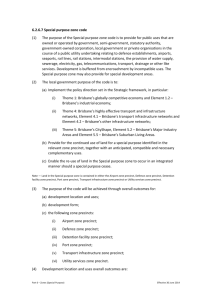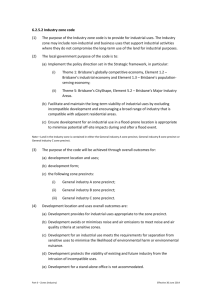6.2.6.7 Special purpose zone code (1) The purpose of the Special
advertisement
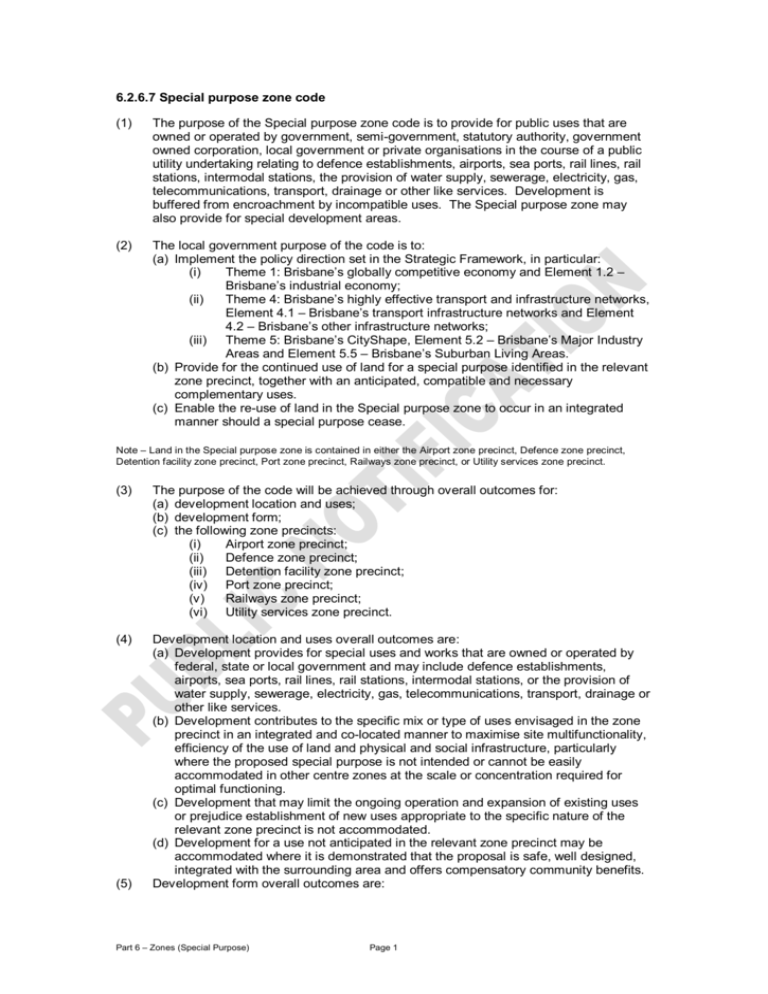
6.2.6.7 Special purpose zone code (1) The purpose of the Special purpose zone code is to provide for public uses that are owned or operated by government, semi-government, statutory authority, government owned corporation, local government or private organisations in the course of a public utility undertaking relating to defence establishments, airports, sea ports, rail lines, rail stations, intermodal stations, the provision of water supply, sewerage, electricity, gas, telecommunications, transport, drainage or other like services. Development is buffered from encroachment by incompatible uses. The Special purpose zone may also provide for special development areas. (2) The local government purpose of the code is to: (a) Implement the policy direction set in the Strategic Framework, in particular: (i) Theme 1: Brisbane’s globally competitive economy and Element 1.2 – Brisbane’s industrial economy; (ii) Theme 4: Brisbane’s highly effective transport and infrastructure networks, Element 4.1 – Brisbane’s transport infrastructure networks and Element 4.2 – Brisbane’s other infrastructure networks; (iii) Theme 5: Brisbane’s CityShape, Element 5.2 – Brisbane’s Major Industry Areas and Element 5.5 – Brisbane’s Suburban Living Areas. (b) Provide for the continued use of land for a special purpose identified in the relevant zone precinct, together with an anticipated, compatible and necessary complementary uses. (c) Enable the re-use of land in the Special purpose zone to occur in an integrated manner should a special purpose cease. Note – Land in the Special purpose zone is contained in either the Airport zone precinct, Defence zone precinct, Detention facility zone precinct, Port zone precinct, Railways zone precinct, or Utility services zone precinct. (3) The purpose of the code will be achieved through overall outcomes for: (a) development location and uses; (b) development form; (c) the following zone precincts: (i) Airport zone precinct; (ii) Defence zone precinct; (iii) Detention facility zone precinct; (iv) Port zone precinct; (v) Railways zone precinct; (vi) Utility services zone precinct. (4) Development location and uses overall outcomes are: (a) Development provides for special uses and works that are owned or operated by federal, state or local government and may include defence establishments, airports, sea ports, rail lines, rail stations, intermodal stations, or the provision of water supply, sewerage, electricity, gas, telecommunications, transport, drainage or other like services. (b) Development contributes to the specific mix or type of uses envisaged in the zone precinct in an integrated and co-located manner to maximise site multifunctionality, efficiency of the use of land and physical and social infrastructure, particularly where the proposed special purpose is not intended or cannot be easily accommodated in other centre zones at the scale or concentration required for optimal functioning. (c) Development that may limit the ongoing operation and expansion of existing uses or prejudice establishment of new uses appropriate to the specific nature of the relevant zone precinct is not accommodated. (d) Development for a use not anticipated in the relevant zone precinct may be accommodated where it is demonstrated that the proposal is safe, well designed, integrated with the surrounding area and offers compensatory community benefits. Development form overall outcomes are: (5) Part 6 – Zones (Special Purpose) Page 1 (a) Development is appropriately located according to the proposed use, and building and landscape design are of a scale, height and bulk that is generally compatible with the surrounding area and transitions sensitively to surrounding uses. (b) Development creates a variety of building forms, materials and façade treatments. (c) Development is provided with servicing and utilities infrastructure that are commensurate with the level of service demands of the use. (d) Development is supported by complementary uses of an appropriate scale and purpose to directly serve the employees and activities of the zone precinct, which do not compromise the commercial, retail or community service role and function of nearby centre activities. (e) Development minimises adverse impacts (including glare, odour, light, noise, traffic, parking, servicing and hours of operation) on the health, safety and amenity of adjoining sensitive land uses, predominantly through maintaining adequate buffering between these land uses. (f) Development achieves a satisfactory standard of environmental performance by principles of innovative, sustainable and efficient design, construction and operation, to encourage water conservation and responsiveness to climate. (g) Development maximises road, rail, public transport and transport connections and accessibility between the Special purpose zone and key destinations to ensure efficient and safe movement of people, goods and freight and accessibility for visitors, patrons and employees. (h) Development for a special purpose that is a major economic driver, such as a port or airport consolidates its role in facilitating trade growth via bringing allied industries, freight and tourism to the region and functioning as a major employment generator. (i) Development is designed, constructed and operated to maintain the safety and security of people and property. (j) Development responds to land constraints, mitigates any adverse impacts on environmental values and natural features, and addresses other specific characteristics, as identified by overlays affecting the site or in codes applicable to the development. (6) Airport zone precinct form overall outcomes are: (a) Development provides areas for: (i) housing, servicing, maintenance and repair of aircraft; (ii) landing and departure of aircraft; (iii) assembly and dispersal of passengers and goods on or from aircraft; (iv) ancillary activities serving the needs of workers, passengers and visitors to an airport, such as shopping, food and drink outlets and tourism services; (v) associated training, education and aviation facilities. (7) Defence zone precinct overall outcomes are: (b) Development is located on land for defence and communication facilities administered by the Australian Government Department of Defence. (8) Detention facility zone precinct overall outcomes are: (a) Development provides for the confinement of persons committed by a process of law, such as a prison or detention centre. (9) Port zone precinct overall outcomes are: (a) Development provides areas for: (i) housing, servicing, maintenance and repair of ships; (ii) arrival and departure of ships; (iii) assembly and dispersal of passengers and goods on or from ships; (iv) ancillary activities serving the needs of workers, passengers and visitors to a port, such as shopping, food and drink outlets and tourism services. (10) Railways zone precinct overall outcomes are: (a) Development provides for activities and associated facilities that support the effective functioning of a railway system. Part 6 – Zones (Special Purpose) Page 2 (11) Utility services zone precinct overall outcomes are: (a) Development provides for: (i) the supply of water, hydraulic power, electricity or gas; (ii) sewerage, drainage or stormwater services; (iii) transport services; (iv) waste management services; (v) postal or telecommunications services; (vi) associated offices and network infrastructure for the provision of public services. Part 6 – Zones (Special Purpose) Page 3
